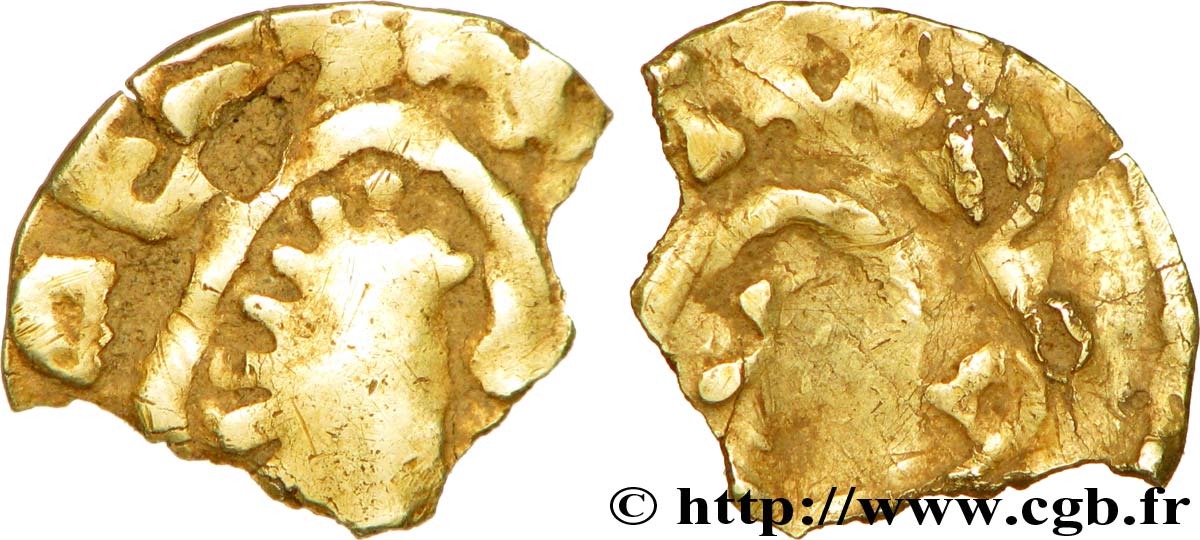bmv_223492 - MEROVINGIAN COINAGE - TOULOUSE (TOLOSA) - Aquitania Triens à la tête stylisée, fragmentaire
Not available.
Item sold on our e-shop (2011)
Price : 420.00 €
Item sold on our e-shop (2011)
Price : 420.00 €
Type : Triens à la tête stylisée, fragmentaire
Date: VIIe siècle
Mint name / Town : Toulouse (31)
Metal : gold
Diameter : 12 mm
Orientation dies : 11 h.
Weight : 0,77 g.
Rarity : R3
Coments on the condition:
Monnaie fragmentaire, avec des cassures irrégulières. Le flan est voilé avec quelques défauts de surface, de frappe assez vigoureuse au droit, mais molle au revers. Restes de concrétions terreuses dans les creux
Obverse
Obverse legend : [+ TOLO - S]AE=C.
Obverse description : Tête barbare diadémée, les cheveux hirsutes, à droite ; un astre devant le front et la légende autour.
Reverse
Reverse legend : [+ PIASSCVV].
Reverse description : Une croix à six bras (?), dans un grènetis intérieur ; légende autour du grènetis.
Commentary
Cette monnaie fragmentaire est du même type que le n° 1196 au sujet duquel nous écrivions :
“ Si la légende de droit, TOLOSA, ne laisse guère de doute sur l'attribution de ce triens à Toulouse, il reste difficile à classer et à intégrer dans un monnayage de Toulouse déjà très varié et hétérogène. Avec un flan si large, ce triens pourrait rappeler certaines frappes wisigothiques. Mais Toulouse n’est pas repris comme atelier des Wisigoths et si certaines monnaies peuvent présenter une tête de profil avec ce genre de coiffure, aucune monnaie wisigothique ne présente un tel revers.
Quoi qu’il en soit, cette monnaie d’un style très barbare, mais sur un flan en bon or, semble complètement unique et sans équivalent ”.
Sur cet exemplaire, le début de la légende TOLO est hors flan, mais les similitudes avec le triens de MONNAIES 43 ne laisse aucun doute !.
“ Si la légende de droit, TOLOSA, ne laisse guère de doute sur l'attribution de ce triens à Toulouse, il reste difficile à classer et à intégrer dans un monnayage de Toulouse déjà très varié et hétérogène. Avec un flan si large, ce triens pourrait rappeler certaines frappes wisigothiques. Mais Toulouse n’est pas repris comme atelier des Wisigoths et si certaines monnaies peuvent présenter une tête de profil avec ce genre de coiffure, aucune monnaie wisigothique ne présente un tel revers.
Quoi qu’il en soit, cette monnaie d’un style très barbare, mais sur un flan en bon or, semble complètement unique et sans équivalent ”.
Sur cet exemplaire, le début de la légende TOLO est hors flan, mais les similitudes avec le triens de MONNAIES 43 ne laisse aucun doute !.








 Report a mistake
Report a mistake Print the page
Print the page Share my selection
Share my selection Ask a question
Ask a question Consign / sell
Consign / sell